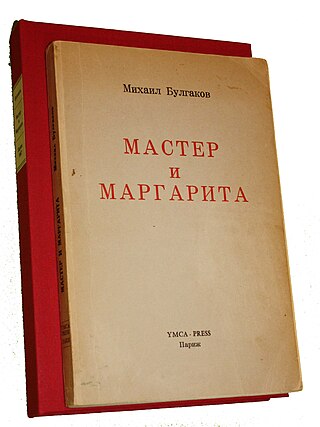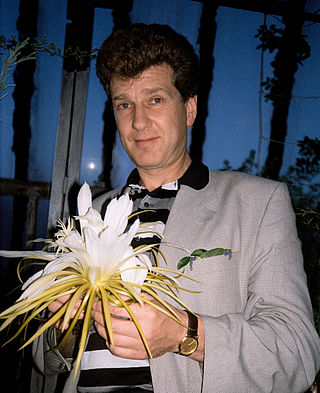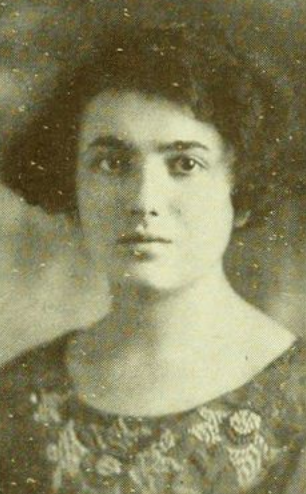Related Research Articles

Yevgeny Ivanovich Zamyatin, sometimes anglicized as Eugene Zamyatin, was a Russian author of science fiction, philosophy, literary criticism, and political satire.

Mikhail Afanasyevich Bulgakov was a Russian, later Soviet writer, medical doctor, and playwright active in the first half of the 20th century. He is best known for his novel The Master and Margarita, published posthumously, which has been called one of the masterpieces of the 20th century.

Novodevichy Cemetery is a cemetery in Moscow. It lies next to the southern wall of the 16th-century Novodevichy Convent, which is the city's third most popular tourist site.

We is a dystopian novel by Russian writer Yevgeny Zamyatin, written 1920–1921. It was first published as an English translation by Gregory Zilboorg in 1924 by E. P. Dutton in New York, with the original Russian text first published in 1952. The novel describes a world of harmony and conformity within a united totalitarian state. It influenced the emergence of dystopia as a literary genre. George Orwell said that Aldous Huxley's 1931 Brave New World must be partly derived from We, although Huxley denied this. Orwell's own Nineteen Eighty-Four (1949) was also inspired by We.

The Master and Margarita is a novel by Soviet writer Mikhail Bulgakov, written in the Soviet Union between 1928 and 1940. A censored version, with several chapters cut by editors, was published in Moscow magazine in 1966–1967, after the writer's death, by his widow Elena Bulgakova. The manuscript was not published as a book until 1967, in Paris. A samizdat version circulated that included parts cut out by official censors, and these were incorporated in a 1969 version published in Frankfurt. The novel has since been published in several languages and editions.

Sergei Nikolayevich Bulgakov was a Russian Orthodox theologian, priest, philosopher, and economist. Orthodox writer and scholar David Bentley Hart has said that Bulgakov was "the greatest systematic theologian of the twentieth century." Father Sergei Bulgakov also served as a spiritual father and confessor to Mother Maria Skobtsova.

Sophiology is a controversial school of thought in Russian Orthodoxy which holds that Divine Wisdom is to be identified with God's essence, and that the Divine Wisdom is in some way expressed in the world as 'creaturely' wisdom. This notion has often been understood or misunderstood as introducing a feminine "fourth hypostasis" into the Trinity.
Paul Oser Zelinsky is an American illustrator and writer who illustrated children's picture books. He won the 1998 Caldecott Medal for U.S. picture book illustration, for Rapunzel. His most popular work is Wheels On the Bus, a best-selling movable book.

Mikhail Bulgakov Museum is a museum in Kyiv, Ukraine, dedicated to Kyiv-born Russian writer Mikhail Bulgakov.
The following is a bibliography of the works of Mikhail Bulgakov in English and Russian.
The Fatal Eggs is a novella by Mikhail Bulgakov, a Soviet novelist and playwright. It was written in 1924 and first published in 1925. The novel became quite popular, but was much criticised by most Soviet critics as a mockery of the Russian Revolution of 1917 and the leadership of Soviet Russia.

Igor Matveyevich Kostolevsky is a Soviet and Russian stage and film actor. He has received the People's Artist of Russia title in 1995. Kostolevsky is best known for starring in the films Teheran 43 and The Captivating Star of Happiness.
Günzburg, a surname of Bavarian origin. Ginsberg, Ginsburg, Gensburg, Ginsburgh, Ginzberg, Ginzborg, and Ginzburg are variants of the surname.

Mirra Komarovsky, was an American pioneer in the sociology of gender.
Yefim Abramovich Gamburg was a Soviet and Russian animation director known for parody and musical cartoons. He was named Meritorious Artist of RSFSR in 1986. Member of ASIFA.
Anita Lobel is a Polish-American illustrator of children's books, including On Market Street, written by her husband Arnold Lobel and a Caldecott Honor Book for illustration, A New Coat for Anna, Alison's Zinnia, and This Quiet Lady. One Lighthouse, One Moon, one of three books she created about her cat, Nini, is a New York Times Best Illustrated Book. Her childhood memoir, No Pretty Pictures, was a finalist for the National Book Award.

The Bulgakov House is situated on the ground floor of Bolshaya Sadovaya ulitsa no. 10 in Moscow, in the building where the Soviet writer Mikhail Bulgakov used to live, and in which some major scenes of his novel The Master and Margarita are set. The museum was established as a private initiative on May 15, 2004.
The year 1925 was marked, in science fiction, by the following events.
Vekhovstvo (vekhovtsy) was a philosophical and socio–political trend in the Russian intellectual environment at the beginning of the 20th century, which got its name from the program collection Vekhi (1909). The initiator of the publication of the latter was Mikhail Gershenzon.
References
- ↑ Rita Berman Frischer, Mirra Ginsburg 1909-2000, Jewish Women's Archive Encyclopedia